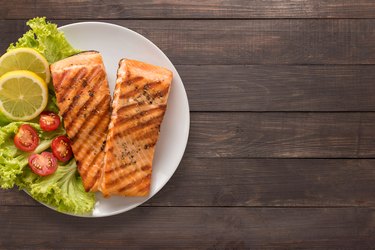
When you're looking for a hearty meal, but you are watching your fat intake, you'll naturally want to include some lean protein in your diet. Check out the leanest meats to add to your plate.
Tip
Although some might not consider it actual meat, fish is the leanest flesh to consume. It's not usually sold in the meat aisle.
Video of the Day
Know USDA Recommendations
The U.S. Department of Agriculture recommends that average adults and children on a 2,000-calorie-per-day diet should consume 5.5 ounces of lean protein per day. However, the agency recommends that only half of that amount — roughly two to three ounces — be consumed in the form of meat.
Video of the Day
An egg, for example, counts as an ounce of protein, and ½ cup of cooked black beans counts as two. Beware of adding more than an ounce of nuts to your daily diet, as they're high in calories. One ounce of almonds would be approximately 20 to 24 nutmeats, according to the USDA.
How you prepare meat also has a significant effect on fat levels. Bake or broil muscle meats, such as beef, pork and poultry. Steam or poach fish and other seafood. Avoid frying food, which adds extra fat that counteracts your lean choices.
Enjoy the Leanest Flesh
Although not technically defined as meat by the Merriam-Webster Dictionary, fish and fowl serve up the leanest choices when you're watching fat intake. They are your best choice.
Steamed or poached cod is the leanest choice you can make, with less than ½ gram of fat in a 3-ounce serving, according to the USDA FoodData Central website. This portion contains under 20 ounces of protein, and less than 100 calories.
Bake or broil three ounces of orange roughy and get up 19 grams of protein, accompanied by just 0.75 grams of fat. This portion has only 89 calories, as per the USDA.
Read more: What is the Healthiest Meat?
Or steam three ounces of shrimp — roughly four to five, according to Reference.com. Although they have more cholesterol than most meats — 161 milligrams in a 3-ounce serving — which is more than half of the Food and Drug Administration's daily recommendation of fewer than 300 milligrams. Shrimp is rich in Omega 3 fatty acids, and contains a carotenoid nutrient known as astaxanthin that acts as an antioxidant and anti-inflammatory, according to the George Mateljan Foundation's World's Healthiest Foods.
Discover the "White Meats"
Although it is technically red meat according to the USDA, pork is commonly called "the other white meat," as it is often compared with poultry when it comes to low-fat eating. Of course, the leanness of the meat depends on which cut you choose, and how you prepare the meat. Remove skin from poultry, advises the USDA, and bake, roast or broil both poultry and pork, for the lowest fat content.
Better yet, stew a chicken breast for the leanest meat, with the most protein. You'll get 21 grams of protein with less than 3 grams of fat, according to USDA FoodData Central. Roasting, baking or broiling increases the fat count slightly, to just over 3 grams.
Pork chops are some of the leanest cuts of pork, at 2 grams of fat and 13 grams of protein per 3-ounce serving. Roast pork tenderloin is another good choice, at less than 3 grams of fat per 3-ounce serving.
Avoid ham and other processed meat, which are high in fats, nitrates and potential carcinogens. Instead, make your own homemade sausage patties from 96 percent lean pork crumbles, which contain just 5 grams of fat per 3 ounce serving.
Consider Lean Red Meats
It's easy to choose the leanest cuts of beef at the supermarket. Meat labeled as lean must contain less than 10 grams of fat per 100 grams; extra-lean meat has less than 5 grams of fat per 100 grams, according to the American Cancer Society.
Knowing how to read a USDA label will give a clue to its fat content. Meat suppliers pay the USDA to grade beef, veal and lamb; however, what grade the meat receives is up to the USDA.
USDA "prime" beef, veal or lamb is from young animals and has abundant fat marbling throughout, making it the highest-fat-content beef you can buy. Most of the USDA "prime" beef goes to restaurants and other upscale food suppliers. USDA "choice" meat has less marbling, but still contains a significant amount of fat throughout, which makes it well-suited for roasting or braising.
USDA "select" is the leanest of the graded meats, so only tender cuts like sirloins, ribs and loins should be cooked using dry methods such as grilling, according to the USDA. Meat that isn't labeled with a grade is standard or commercial grade, and usually what you will find in your local grocery store. Low-graded meats such as "cutter", "canner" and "utility" get used in ground meat and processed meat products.
When there is no USDA grade label, look for meat with the least amount of marbling. Some of the leanest cuts include USDA "select" beef round steak or USDA "select" beef round tip roast, both trimmed to 0 inches of fat, at roughly 4 grams per 3-ounce serving.
- U.S. Department of Agriculture: "FoodData Central"
- U.S. Department of Agriculture: "Look for Lean Protein Foods"
- Merriam-Webster Dictionary: "Definition of Meat"
- Reference.com: "How Many Shrimp Are in 3 Ounces?"
- FDA: "Cholesterol"
- U.S. Department of Agriculture: "USDA Nutrient Data Set for Fresh Pork "
- American Cancer Society: "Understanding Food Terms"